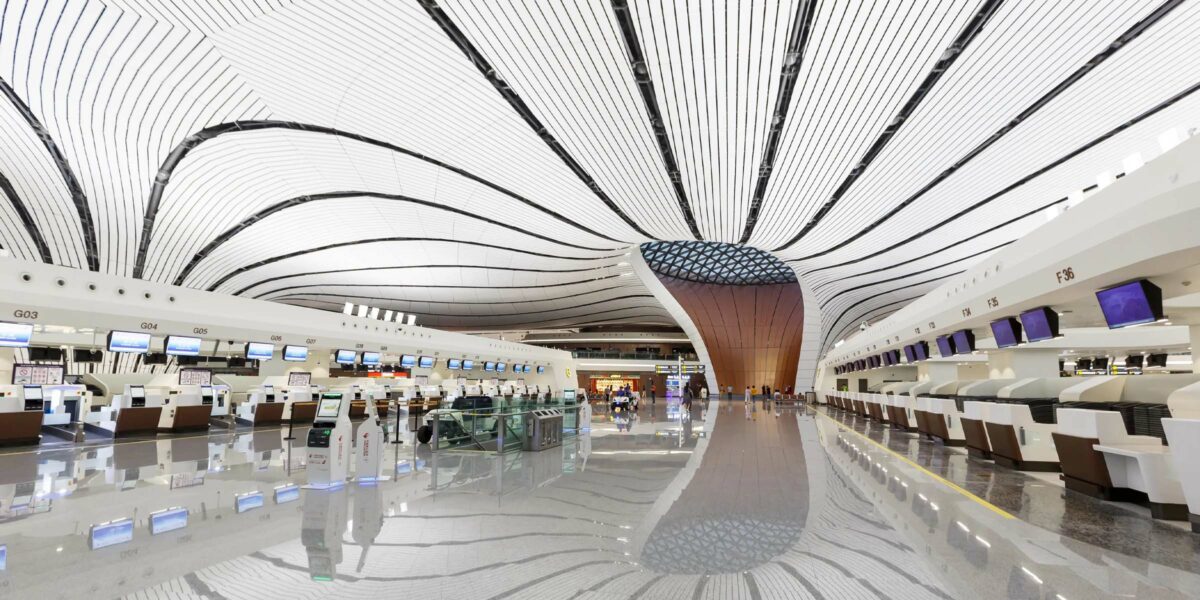Landing at some of the world’s largest airports in the world is a journey on its own. A microcosm of humankind and international influences, these aviation meccas are seemingly void of uniform times and cultures. Instead, passengers live by their own set of rules, infusing the shared space with diversity and a reprieve from societal expectations. On one hand, we have families from the East indulging in pancakes and coffee for breakfast. And on the other, we have the young twenty-year-olds from the West starting their evening with a couple of pints.
Naturally, a long layover seldom makes your travel itinerary by choice. And whilst, you could spend the hours sleeping off jet lag in the nearest lounge—we say, why not embrace it?
Flying high above the rest, the largest airports in the world epitomize extravagance and decadence. Besides providing the opportunity to get in those much-needed steps between endless hours of inertia, you could see them as a coincidental collection of all our favorite things. High-end boutiques put a new spin on the world as our runway, granting the perfect excuse to splurge on this season’s latest trends. Soul-stirring spas grasp the jet-set lifestyle with mesmerizing massages and stress-relieving saunas. And international gastronomes are a portal to untravelled continents and culturally-rich cuisines.
Ready for take off? We’re off to a fly start with a list of the largest airports in the world by size and the world’s largest airports by passenger traffic.
The 10 largest airports in the world
| # | Airport | Size |
| 10. | Bangkok Suvarnabhumi International | 348,750,698 sq ft |
| 9. | Cairo International | 390,729,948 sq ft |
| 8. | Shanghai Pudong International | 429,480,026 sq ft |
| 7. | Houston George Bush Intercontinental | 478,994,014 sq ft |
| 6. | Beijing Daxing International | 501,598,225 sq ft |
| 5. | Washington Dulles International | 523,126,046 sq ft |
| 4. | Orlando International | 627,535,977 sq ft |
| 3. | Dallas Fort Worth International | 752,397,338 sq ft |
| 2. | Denver International | 1,460,662,643 sq ft |
| 1. | Dammam King Fahd International | 8,352,794,483 sq ft |
Bangkok Suvarnabhumi International, Thailand—32.4km2 (348,750,698 sq ft)
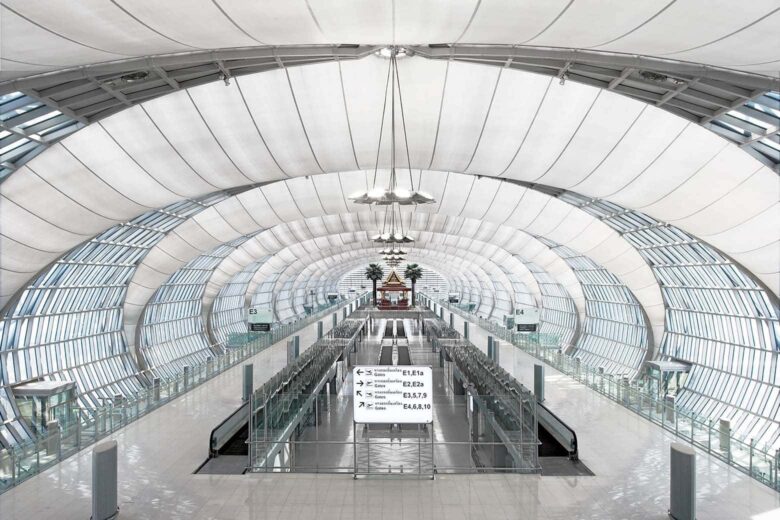
Besides being the major hub for transfer to Southeast Asia, Suvarnabhumi International Airport is renowned as one of the coolest airports on the planet. Lit up at night, the state-of-the-art architecture is an aura of opulence. And the glossy marble floors and high ceilings provide an oasis for futuristic technologies and cutting-edge designs.
As one of the top 10 biggest airports in the world, Suvarnabhumi International offers free Wi-Fi access to all passengers. Whilst automated check-ins and high-standard services prioritize convenience and a smooth-sailing experience. Duty-free outlets reflect the resplendence of Bangkok’s shopping culture. And of course, a Pad Thai and Thai massage is the only way to start or end your Thai vacation.
| Size: | 348,750,698 sq ft (32,400,000m2) |
| Location: | Bangkok, Thailand |
| IATA airport code: | BKK |
| Runways: | 2 |
| Longest runway: | 13,123 ft (4,000 m) |
| Airlines: | 98 |
| Destinations: | 121 |
| Opened in: | 2006 |
| Annual passengers: | 167,510 |
Cairo International, Egypt—36.3km2 (390,729,948 sq ft)
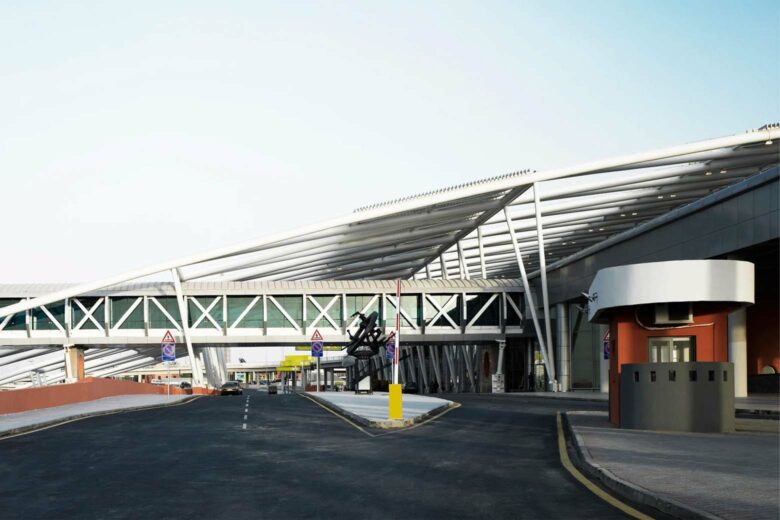
Whether visiting the pyramids stopping over en route your wild safari adventure, Cairo International Airport is ideal for luxury travel seekers. Opened in 1963, the enormous terminal buildings pay homage to the history of the country. Whilst modern renovations speak to a hassle-free experience.
The undulating ceilings create a sense of continuity and openness. The duty-free hub reflects the local culture, drawing inspiration from the Khan al-Khalili bazaar in Cairo. And palm trees scattered around the terminals add a touch of Cairo’s natural beauty throughout the action-packed hub. The airport’s concierge service includes a personal chauffeur, luggage handling and VIP lounge access. But if you don’t need all that, the diverse selection of Middle Eastern cuisines and spa treatments is our preferred way to pass the time.
| Size: | 390,729,948 sq ft (36,300,000m2) |
| Location: | Cairo, Egypt |
| IATA airport code: | CAI |
| Runways: | 4 |
| Longest runway: | 13,123 ft (4,000m) |
| Airlines: | 45 |
| Destinations: | 81 |
| Opened in: | 1963 |
| Annual passengers: | 14,7 million |
Shanghai Pudong International, China—39.9km2 (429,480,026 sq ft)
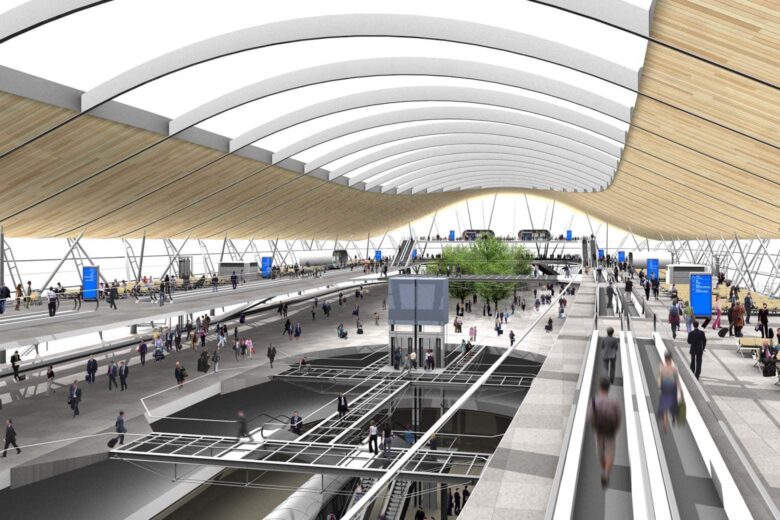
Touching down in the ultra-modern business hub—Pudong—is an experience itself. Shanghai Pudong International is not only one of the largest airports in the world, but it is also one of the cleanest and most streamlined airport experiences. All 90 boarding gates are equipped with monitors providing real-time flight information. And the friendly trilingual staff are well-equipped to assist you with any concerns or questions.
Built like a giant H, Shanghai Pudong International has two terminals, which are connected by a 600m. The cascading infrastructure looks out onto city views and skyrise buildings. Whilst state-of-the-art amenities such as lounges, spas, shopping centers, and restaurants prepare you for take off.
| Size: | 429,480,026 sq ft (39,900,000m2) |
| Location: | Shanghai, China |
| IATA airport code: | PVG |
| Runways: | 4 |
| Longest runway: | 13,123 ft (4,000m) |
| Airlines: | 100 |
| Destinations: | 250 |
| Opened in: | 1963 |
| Annual passengers: | 32,2 million |
George Bush Intercontinental, Houston—44.5km2 (478,994,014 sq ft)

When it comes to George Bush Intercontinental Airport, it’s all about the finer details. From seamless check-ins to well-regulated security lines to live music performances, this is a layover we don’t mind adding to our travel itineraries.
Child daycare facilities grant the perfect excuse to indulge in some much-needed me time at the spa. And a range of gourmet restaurants promises to kickstart your holiday with a bang. The extensive selection of high-end duty-free shops is all you need for those last-minute gifts. While thoughtful considerations such as scattered water-filling stations and streamlined ticket processing emphasize comfort and convenience.
| Size: | 478,994,014 sq ft (44,500,000m2) |
| Location: | Houston, Texas, United States |
| IATA airport code: | IAH |
| Runways: | 5 |
| Longest runway: | 12,001 ft (3,658m) |
| Airlines: | 27 |
| Destinations: | 179 |
| Opened in: | 1969 |
| Annual passengers: | 32,2 million |
Beijing Daxing International, China—46.6km2 (501,598,225 sq ft)
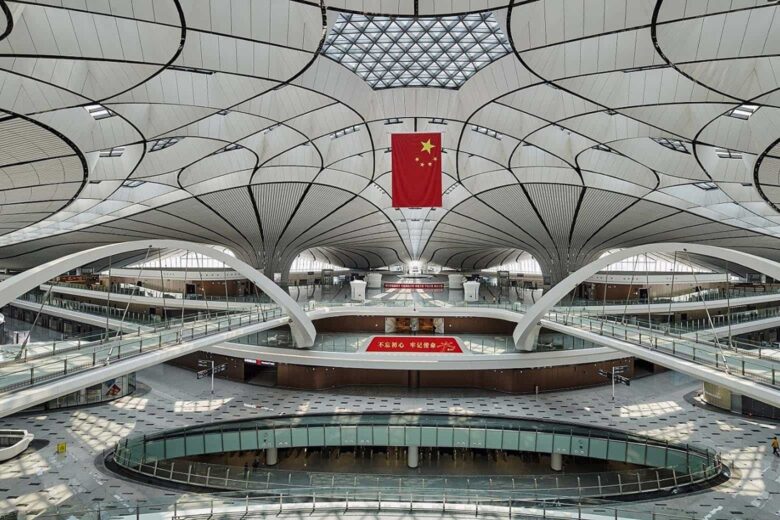
Opened in 2019, Beijing Daxing International is a timewarp into the future of travel. Nicknamed the starfish, the design of the building pays homage to traditional Chinese architecture with six interconnected spaces organized around a central courtyard. But it’s the cutting-edge amenities and customer support robots that make it a favorite amongst travelers.
Designed to alleviate congestion, the main terminal is the size of 97 football fields, making it the largest single-building airport terminal in the world. And whilst this is impressive enough, the white modern minimalist features 8-foot high ceilings, making it appear even bigger in size. Worried you’ll get lost locating the nearest spa, restaurant or shop? Just ask the nearest humanoid robot—they’ll tell you where to go.
| Size: | 501,598,225 sq ft (46,600,000m2) |
| Location: | Beijing, China |
| IATA airport code: | PKX |
| Runways: | 4 |
| Longest runway: | 12,467 ft (3,800m) |
| Airlines: | 24 |
| Destinations: | 147 |
| Opened in: | 2019 |
| Annual passengers: | 25,1 million |
Dulles International, Washington D.C, USA—48.6km2 (523,126,046 sq ft)

Comfort is key. And for Washington Dulles International that means speedy security lines and of course, the iconic mobile lounges. Designed to ferry passengers with minimal effort, the mobile lounges were the first of their kind. Today, many passengers opt to use the slick underground AeroTrain, although the historic mobile lounges are still in use.
Besides its extravagant size and tech-savvy transportation methods, the most notable features of Washington Dulles International include its well-known curved roof and historic air traffic control tower—both of which are impossible to miss from the skies. However, if you’re more interested in what’s on the inside, the kid’s play area is a win for burnt-out parents. While Chipotle’s “airport only” breakfast burritos are a win for all.
| Size: | 523,126,046 sq ft (48,600,000m2) |
| Location: | Washington D.C, United States |
| IATA airport code: | IAD |
| Runways: | 4 |
| Longest runway: | 11,500 ft (3,505m) |
| Airlines: | 30 |
| Destinations: | 136 |
| Opened in: | 1962 |
| Annual passengers: | 15 million |
Orlando International, Florida, USA—53.8km2 (627,535,977 sq ft)
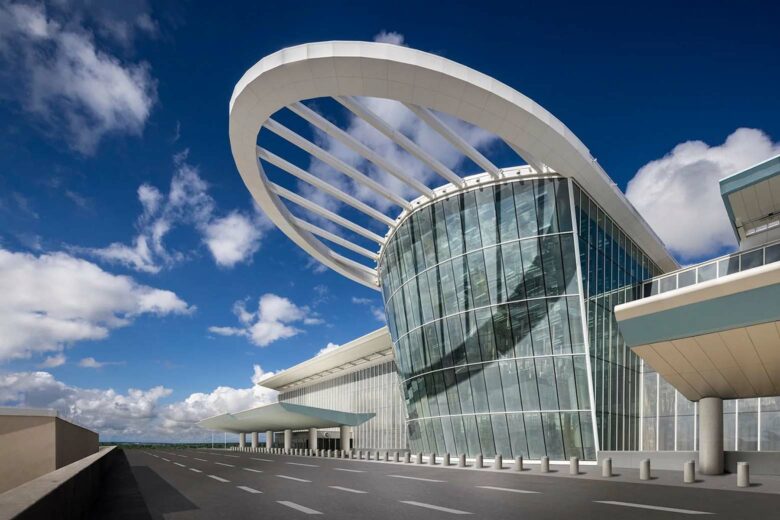
Bright artworks and plenty of activity: we can’t help but feel like a kid again at Orlando International. Even if Disney World isn’t the ordre du jour.
The astronomical airport has a fairytale feel, featuring towering shaped trees, resplendent hues and elegant modern facilities. Sticking to the magical theme, Universal’s Harry Potter shop is a favorite amongst kids—and you won’t find the same queues as you do at the main store. The arcade is also a good way to keep children entertained and buy yourself some free time. And if you didn’t make the trip to Disney World, you can always make up for it at the Disney merchandise store. Cue the last minute gift shopping!
| Size: | 627,535,977 sq ft (53,800,000m2) |
| Location: | Orlando, Florida, United States |
| IATA airport code: | MCO |
| Runways: | 4 |
| Longest runway: | 12,005 ft (3,659m) |
| Airlines: | 44 |
| Destinations: | 135 |
| Opened in: | 1940 |
| Annual passengers: | 40,4 million |
Fort Worth International, Dallas, USA—69.6km2 (752,397,338 sq ft)
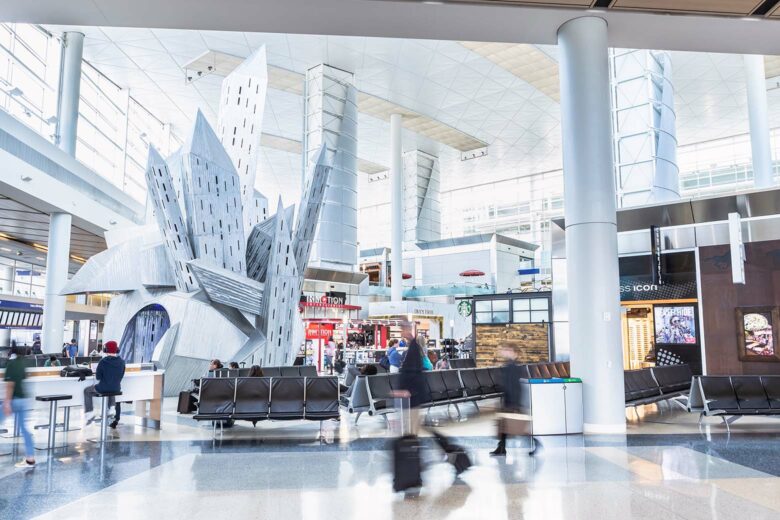
Eco travelers unite: Dallas Fort Worth International is the largest carbon neutral airport in the world. By using renewable energies to reduce its carbon footprint and offsetting the difference with environmentally positive initiatives, this sustainable airport takes a balanced approach to eco-chic travel.
Besides being one of the largest airports, Dallas Fort Worth is also the second busiest international airport in the world. With seven runways, the airport is able to accommodate multiple flights at once, reducing the risk of delays and flight cancellations. And cutting edge technologies also mean that despite the busyness of the airport, check-ins and security queues are slick and streamlined, allowing you to spend most of your time enjoying a coffee or making the most of the complimentary Wi-Fi.
| Size: | 752,397,338 sq ft (69,600,000m2) |
| Location: | Dallas, Texas, United States |
| IATA airport code: | DFW |
| Runways: | 7 |
| Longest runway: | 13,401 ft (4,085m) |
| Airlines: | 28 |
| Destinations: | 260 |
| Opened in: | 1973 |
| Annual passengers: | 62,5 million |
Denver International, Colorado, USA—135.7km2 (1,460,662,643 sq ft)
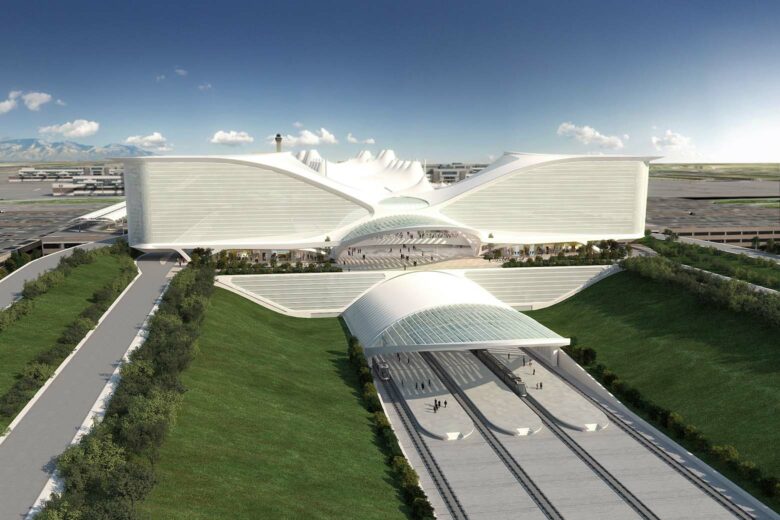
We don’t usually associate travel with zen-like behaviors—quite the opposite in fact. But when you’re awaiting a flight at the largest airport in the U.S. with free yoga classes twice daily, it’s impossible not to feel anything but cool, calm and collected. Especially when massage chairs are abundant and private showers are available for rent.
Drawing inspiration from nature, Denver International’s design reflects that of the native Rocky Mountains. And instantly recognizable from the air, the white peaked roofs exude a feeling of whimsy and serenity. While local artworks tell a story of world peace, hope, and a healthy environment. A yogi-haven, don’t be surprised if you land up at one of the airport’s many vegan-friendly restaurants. It’s infectious.
| Size: | 1,460,662,643 sq ft (135,700,000m2) |
| Location: | Denver, Colorado, United States |
| IATA airport code: | DEN |
| Runways: | 6 |
| Longest runway: | 16,000 ft (4,800m) |
| Airlines: | 25 |
| Destinations: | 215 |
| Opened in: | 1995 |
| Annual passengers: | 58,8 million |
King Fahd International, Dammam, Saudi Arabia—776km2 (8,352,794,483 sq ft)
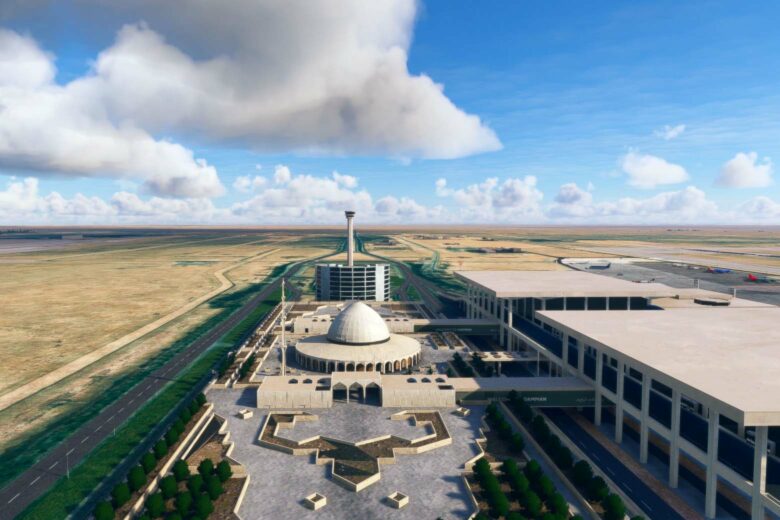
As the largest airport in the world by far, King Fahd International is a mini city within itself. The 776km2 airport comprises three terminals. The Aramco Terminal is exclusively operated by private airline Saudi Aramco. The Royal Terminal is reserved for the Saudi royal family, government personnel, and official guests. Whilst the main terminal is the one used by everyone else.
The main terminal is a colossal six stories high and includes everything from duty-free shopping to baggage storage to child care rooms. For many, the extravagant mosque on the roof is a big attraction. And the professional medical facility is key for those traveling with potential health risks.
| Size: | 8,352,794,483 sq ft (776,000,000m2) |
| Location: | Dammam, Saudi Arabia |
| IATA airport code: | DMM |
| Runways: | 2 |
| Longest runway: | 13,123 ft (4,000m) |
| Airlines: | 37 |
| Destinations: | 60 |
| Opened in: | 1999 |
| Annual passengers: | 10 million |
The biggest airports in the world: Conclusion
Whilst the size of an airport seldom determines our destination, it could determine our route. The largest airports in the world are typically a lot more luxurious and action-packed. So if you have to decide where to spend a couple of hours in between flights, we recommend looking to these as a guide.
As the biggest airport in the world, King Fahd International was the first in Saudi Arabia to implement duty-free shopping—an essential for frequent flyers and newbies alike. Denver International brings the zen with its mountain-inspired architecture and free yoga classes. While carbon-neutral Dallas Fort Worth is a quintessential stop-over for eco-conscious travelers. And the whimsical Orlando International is a fantasy haven for pent-up children and rest-seeking adults alike.
Naturally, each of these colossal airports brings their character and culture to our travel experiences. But with size on their side, all of them include the luxury travel essentials such as A-list-worthy lounges, high-end shopping, gourmet eateries, and state-of-the-art technologies. So whether you prefer to spend your time at the spa or racking up steps, here are the top 10 largest airports worth adding to your itinerary:
- King Fahd International
- Denver International
- Dallas Fort Worth International
- Orlando International
- Washington Dulles International
- Beijing Daxing International
- George Bush Intercontinental
- Shanghai Pudong International
- Cairo International
- Suvarnabhumi International
The 10 busiest airports in the world
| # | Airport | Annual Passengers |
| 10. | Las Vegas Harry Reid International | 39.8 million |
| 9. | Chengdu Shuangliu International | 40.1 million |
| 8. | Guangzhou Baiyun International | 40.2 million |
| 7. | Orlando International | 40.3 million |
| 6. | Charlotte Douglas International | 43.2 million |
| 5. | Los Angeles International | 48 million |
| 4. | Chicago O’Hare International | 54 million |
| 3. | Denver International | 58.8 million |
| 2. | Dallas Fort Worth International | 62.4 million |
| 1. | Hartsfield–Jackson Atlanta International | 75.7 million |
Harry Reid International, Las Vegas, USA—39.8 million passengers
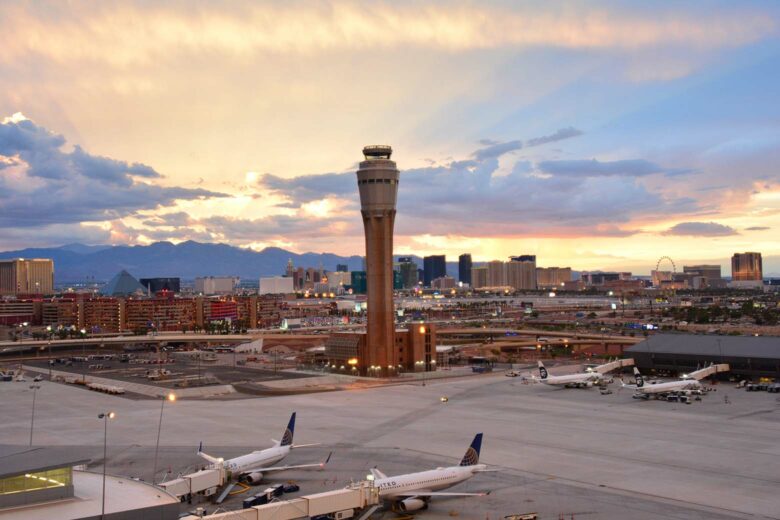
We don’t know whether it’s the airport’s stellar facilities or just the increase in last-minute elopements, but either way Harry Reid International is a hub of activity throughout the year. Located in Las Vegas, the action-packed airport connects passengers to over 100 cities around the world and offers non-stop flights to all America’s hotspots.
But it’s not all hustle and bustle. Considered one of the top 50 airports in the world, modern technologies ensure streamlined operations. And a long list of things to do keeps passengers constantly entertained. Naturally, you can pass time embracing Las Vegas’ iconic reputation at the machine slots. Take a healthier approach and work out at McCarran. Or make the most of the busy airport’s free art gallery and aviation museum.
| Annual passengers: | 39.8 million |
| Size: | 118,403 014 sq ft (11,000,000m2) |
| Location: | Las Vegas, Nevada, United States |
| IATA airport code: | LAS |
| Runways: | 4 |
| Longest runway: | 14,515 ft (4,424 m) |
| Airlines: | 30 |
| Destinations: | 140 |
| Opened in: | 1942 |
Shuangliu International, Chengdu, China—40.1 million passengers
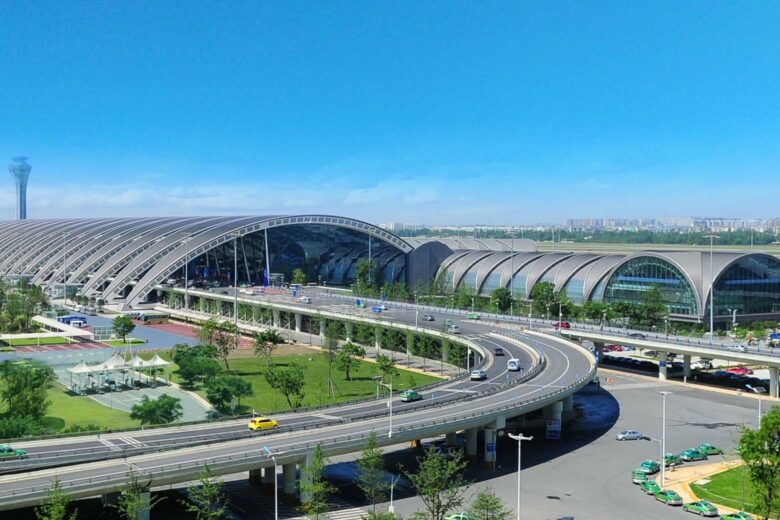
It may not be the biggest airport in the world, but it’s certainly one of the busiest. Chengdu Shuangliu International handles over 40 thousand passengers a year, connecting them to over 100 destinations around the world.
Built in 1838, the aviation mecca is rich with history, although modern amenities are included for optimum comfort. If you have time, luggage storage allows you to ditch the bags and explore the city or visit the pandas. But if you don’t, there are plenty of shopping centers, spas and restaurants to keep you entertained at the airport itself. Personally, we recommend a heartwarming bowl of sizzling spicy Sichuan noodles—the antidote to traveler’s fatigue.
| Annual passengers: | 40.1 million |
| Size: | 7,642,376 sq ft (710,000m2) |
| Location: | Chengdu, China |
| IATA airport code: | CTU |
| Runways: | 3 |
| Longest runway: | 13,123 ft (4,000m) |
| Airlines: | 28 |
| Destinations: | 111 |
| Opened in: | 1838 |
Guangzhou Baiyun International, Guangdong, China—40.2 million passengers
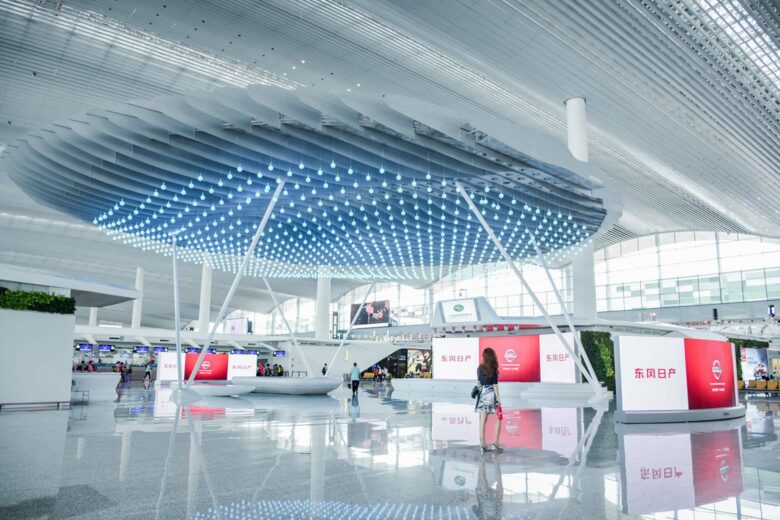
Brimming with excited energy and rainbow lit ceilings, there’s nothing dull about a layover at Guangzhou Baiyun International. Flying to over 200 international destinations with over 80 airlines, it’s no surprise that the Chinese airport is a popular stop-over for many, with annual airport traffic of over 40 million passengers.
Built in 2004, the circular design of Guangzhou Baiyun International draws its inspiration from the local traditional Lingnan gardens as well as the modernity and efficiency of the Chinese city. And it’s also one of the greenest and most sustainable airports in the world. Located 28km of downtown, you’ll need a couple of hours to explore the sites. Otherwise, a Michelin-star meal at the five-star Terminal 2 is just as appealing.
| Annual passengers: | 40.2 million |
| Size: | 155,000,310 sq ft (14,400,000m2) |
| Location: | Guangdong, China |
| IATA airport code: | CAN |
| Runways: | 3 |
| Longest runway: | 12,500 ft (3,800m) |
| Airlines: | 80 |
| Destinations: | 230 |
| Opened in: | 2004 |
Orlando International, Florida, USA—40.3 million passengers

We’ve already mentioned Orlando International as one of the largest airports in the world, but with annual airport traffic of over 40 million passengers, it’s also one of the busiest airports and most comfortable places to spend a layover.
Unlike most international airports, you don’t have to fly first class to experience VIP treatment. Orlando International has two luxury lounges that are open to all passengers—regardless of airline or class. With soft seating, food, drinks, Wi-Fi, and even shower facilities, it’s worth booking and securing your spot ahead of time. Otherwise, 100s of duty-free shops, spas, and gourmet restaurants are the perfect excuse to pamper yourself in between flights.
| Annual passengers: | 40,4 million |
| Size: | 627,535,977 sq ft (53,800,000m2) |
| Location: | Orlando, Florida, United States |
| IATA airport code: | MCO |
| Runways: | 4 |
| Longest runway: | 12,005 ft (3,659m) |
| Airlines: | 44 |
| Destinations: | 135 |
| Opened in: | 1940 |
Charlotte Douglas International, North Carolina, USA—43.2 million passengers
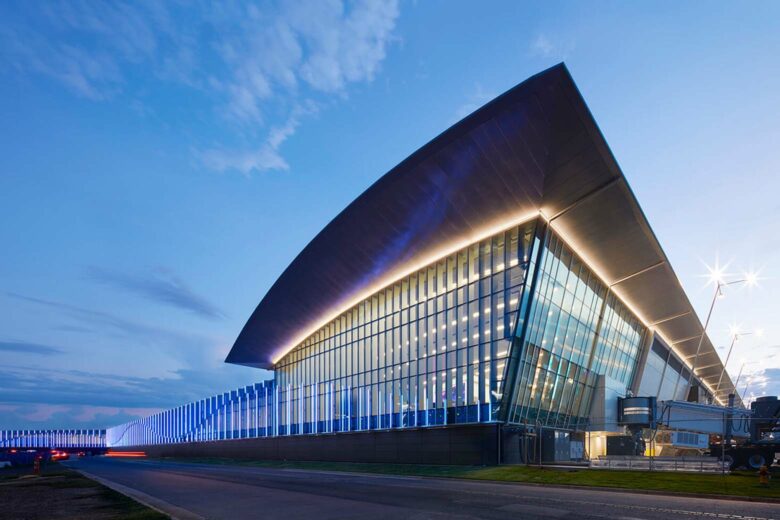
Royalty-approved and traveler-endorsed, Charlotte Douglas International is an architectural marvel. Drawing inspiration from the prominent statue of Queen Charlotte, the elegant design is rich and regal, coupled with touches of southern hospitality.
Located in North Carolina, this airport sees over 43 million passengers a year, hosted in plush lounges and gourmet restaurants. The airport’s art program, Just Plane Art, is an excellent free activity, featuring over 20 local art exhibits. The business center is perfect for business travelers who prefer to spend their layover productively. And designated quiet zones are a game changer for those hoping to sleep off jet lag.
| Annual passengers: | 43.2 million |
| Size: | 242,080,345 sq ft (22,490,000 m2) |
| Location: | Charlotte, North Carolina, United States |
| IATA airport code: | CLT |
| Runways: | 4 |
| Longest runway: | 10,000 ft (3,048m) |
| Airlines: | 13 |
| Destinations: | 188 |
| Opened in: | 1936 |
Los Angeles International—48 million passengers
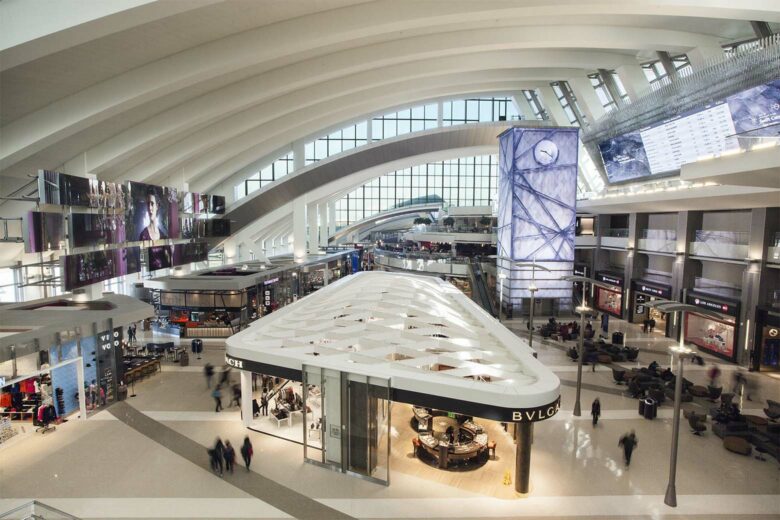
The city of angels and the airport of dreams. Los Angeles International Airport connects travelers to 187 international destinations, making it a hotspot for stopovers. Serving over 48 million passengers throughout the year, the airport is optimized for comfort and convenience.
It’s difficult to just pass through LA without checking out Hollywood and Beverly Hills’ biggest houses in the world and most expensive homes. Fortunately, the airport is relatively close to the city and public buses make it easy to access all the main attractions. If you’re short on time but still itching for fresh air, Manhattan Beach is around the corner. And if you just want to rest with minimal effort, you can’t go wrong with a deep tissue massage at one of the airport spas—you’ve earned it after all those hours on board.
| Annual passengers: | 48 million |
| Size: | 150,694,746 sq ft (14,000,000m2) |
| Location: | Los Angeles, California, United States |
| IATA airport code: | LAX |
| Runways: | 4 |
| Longest runway: | 12,091 ft (3,685m) |
| Airlines: | 66 |
| Destinations: | 187 |
| Opened in: | 1928 |
Chicago O’Hare International, Illinois, USA—54 million passengers
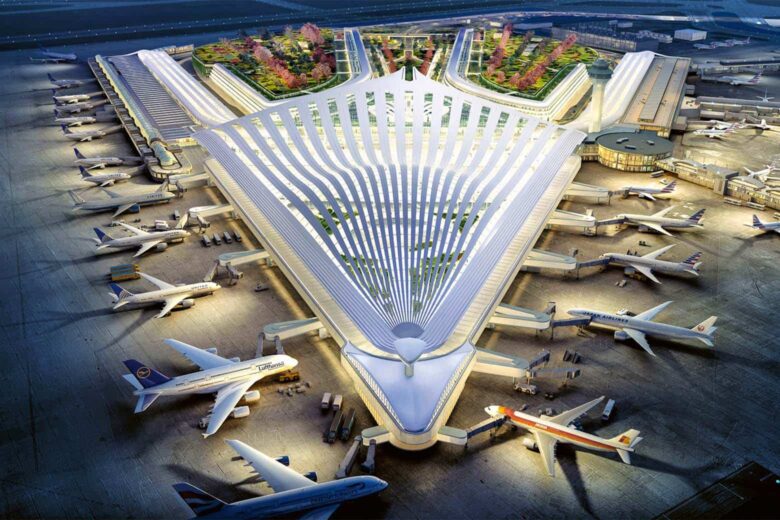
Reflecting a city shaped by lines and movement, Chicago O’Hare International’s tripartite design merges into a single building. Whilst the pronged-shaped architecture references the American city’s unique position along Lake Michigan and the Chicago River.
The Chicago seal also played its part as a muse for the airport design. And “The City in a Garden” is beautifully encapsulated by resplendent florals positioned between clean white infrastructure. The modern facility flaunts four terminals with luxurious amenities such as fine dining restaurants, lounges, spas, shopping centers, and entertainment areas. And with direct flights to over 250 destinations, it’s become the meeting point for over 54 million passengers annually.
| Annual passengers: | 54 million |
| Size: | 313,632,000 sq ft (29,137,366m2) |
| Location: | Chicago, Illinois, United States |
| IATA airport code: | ORD |
| Runways: | 8 |
| Longest runway: | 13,000 ft (3,962m) |
| Airlines: | 45 |
| Destinations: | 258 |
| Opened in: | 1944 |
Denver International, Colorado, USA—58.8 million passengers
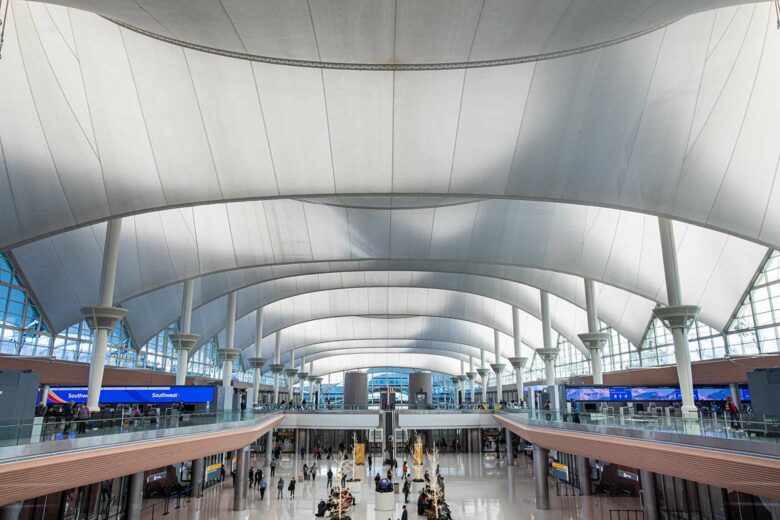
The second biggest airport in the world, Denver International sprawls over 135km2 and sees over 58 million passengers pass through its gates annually. The mecca for travel is located in the Rocky Mountain Region. And despite the colossal size and constant hum of people, it’s actually a pleasant airport to spend a layover.
State-of-the-art security systems have been implemented to eliminate long queues. Automated bag check-ins are hassle-free. And modernized terminals are clean and streamlined for efficiency and entertainment. We particularly recommend popping into Root Down—the first local restaurant to expand to the airport.
| Annual passengers: | 58,8 million |
| Size: | 1,460,662,643 sq ft (135,700,000m2) |
| Location: | Denver, Colorado, United States |
| IATA airport code: | DEN |
| Runways: | 6 |
| Longest runway: | 16,000 ft (4,800m) |
| Airlines: | 25 |
| Destinations: | 215 |
| Opened in: | 1995 |
Fort Worth International, Dallas, USA—62.4 million passengers
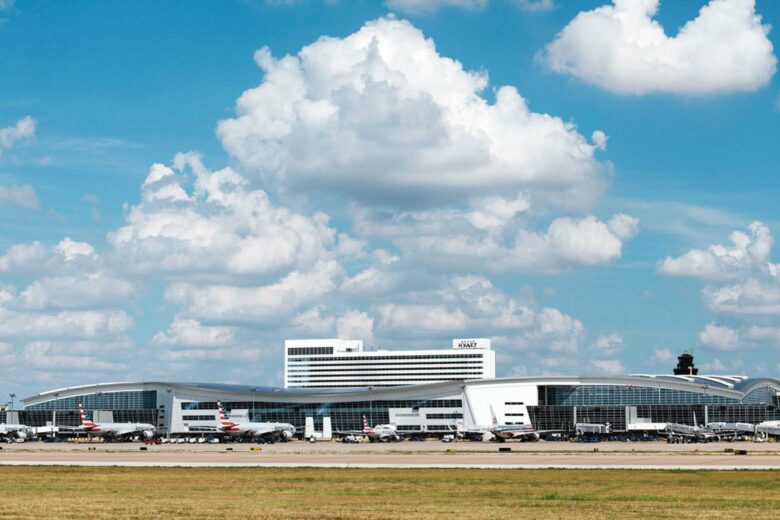
Whether you’ve come to see the Dallas Cowboys or are just passing through, Fort Worth International is one of the busiest airports in the world for good reason. Built in 1973, the iconic airport features five terminals including a luxury terminal with private suites and complimentary gourmet meals prepared by local chefs.
Naturally, if you only have a couple of hours in Texas, you’ll want to make the most of Southern homestyle cooking. Fort Worth International has plenty of eateries that serve up Dallas’ signature barbeque chicken, sandwiches, and frozen yogurt. Eaten yourself into a coma? It’s time to unwind at one of the airport’s many spas.
| Annual passengers: | 62,4 million |
| Size: | 752,397,338 sq ft (69,600,000m2) |
| Location: | Dallas, Texas, United States |
| IATA airport code: | DFW |
| Runways: | 7 |
| Longest runway: | 13,401 ft (4,085m) |
| Airlines: | 28 |
| Destinations: | 260 |
| Opened in: | 1973 |
Hartsfield–Jackson Atlanta International, Georgia, USA—75.7 million passengers
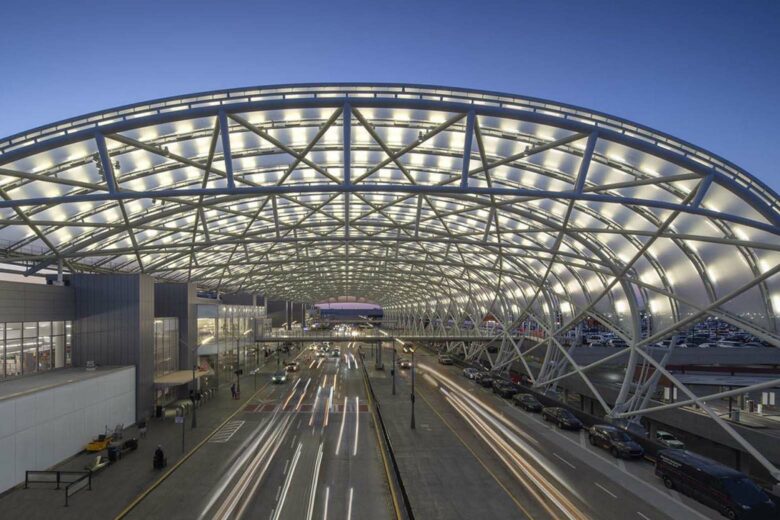
Lit up at night, the red and purple spectacle is impossible to miss from the sky. And even if you’re tired from traveling, the bright LEDs evoke a new sense of excitement.
As the busiest airport in the world, Hartsfield-Jackson Atlanta International Airport sees over 75 million passengers pass through its gates annually. But don’t let that put you off. With modern technologies and efficient systems, the international airport is designed to accommodate a constant flow of international passengers. Over 50 lounges offer complimentary food and drinks. Hundreds of duty-free shops provide the perfect excuse to pack a new wardrobe. And self-driving robot pads make it easier for passengers with limited mobility to navigate the modern facilities.
| Annual passengers: | 75.7 million |
| Size: | 204,732,000 sq ft (19,020,225m2) |
| Location: | Atlanta, Georgia, United States |
| IATA airport code: | ATL |
| Runways: | 5 |
| Longest runway: | 12,390 ft (3776m) |
| Airlines: | 20 |
| Destinations: | 219 |
| Opened in: | 1926 |
The busiest airports in the world: Conclusion
Ok, so you can’t hop onto one of the most expensive private jets or charter the world’s largest yachts, but you can determine how and where you spend an unavoidable layover. And whilst the busiest airports may not necessarily scream luxury, there are actually a few advantages of checking into these action-packed hubs.
International airports that are constantly bustling with passengers are likely to have better facilities and plenty to do. Hartsfield-Jackson Atlanta International—the busiest airport in the world—features over 50 lounges, hundreds of high-fashion boutiques and self-driving robot pads. Dallas Fort Worth International includes a luxury terminal complete with private suites and complimentary gourmet meals. And Chicago O’Hare International is inspired by “A City in the Garden”, ornamented with resplendent florals and featuring some of the most serene spa treatments.
All of the world’s busiest airports are designed for hyper-efficiency with cutting-edge technologies. Think: robot assistants, automated check-ins and streamlined security systems. Plus, we think it’s fun to embrace the excited energy of thousands of people from around the world awaiting their next trip.
On board yet? Here are the top 10 busiest airports in the world:
- Hartsfield–Jackson Atlanta International
- Dallas Fort Worth International
- Denver International
- Chicago O’Hare International
- Los Angeles International
- Charlotte Douglas International
- Orlando International
- Guangzhou Baiyun International
- Chengdu Shuangliu International
- Las Vegas Harry Reid International
Frequently asked questions about the biggest airports in the world
The 10 largest airports in the world are 1. King Fahd International 2. Denver International 3. Dallas Fort Worth International 4. Orlando International 5. Washington Dulles International 6. Beijing Daxing International 7. George Bush Intercontinental 8. Shanghai Pudong International 9. Cairo International 10. Suvarnabhumi International.
The 3 largest airports in the world by size are Dammam King Fahd International Airport, Denver International and Dallas Fort Worth International. The 3 largest airports in the world by airport traffic are Hartsfield–Jackson Atlanta International, Dallas Fort Worth International and Denver International. Check out our list of the largest airports in the world for more information.
King Fahd International Airport is the world’s largest airport by total land area. With an area of 776 square kilometers, it is located near Dammam in the Eastern Province of Saudi Arabia. It has three runways and offers modern facilities for passengers including lounges, duty-free shops, and a prayer room.
Hartsfield-Jackson Atlanta International Airport is the world’s busiest airport, with over 75.7 million passengers every year. It offers nonstop service to more than 219 domestic and international destinations and is home to the world’s longest airport concourse. On the other hand, the least busy airport in the world—Mattala Rajapaksa International Airport in Sri Lanka—sees an average of only 7 passengers a year.
